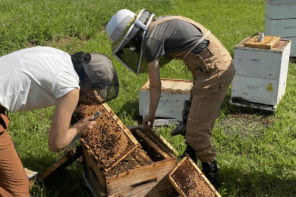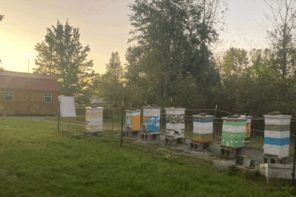By: Charlotte Hubbard
This article originally appeared in the Winter 2016 issue of BEEKeeping Your First Three Years
I fear putting my bees to bed for the Winter because I don’t know what I’ll do with myself. What do people without bees do with all their extra time? Write symphonies? Cure diseases? Use coupons before they expire?
I will so miss working my bees. I love everything about them: popping the inner cover to gaze into all quarter-million of their dark eyes, their awkward pollen-burdened landings, the flat beauty of worker brood. While I don’t love the small hive beetle (SHB), I do find evil delight in halving them with a hive tool.
Historically, “putting the bees to bed” for me has been synonymous with “putting the bees down.” In my early beekeeping years, the only expertise I could claim was the ability to NOT successfully overwinter. Some losses were likely due to the usual mysteries, but the first few years, most of my losses were due to my own stupidity.
As many husbands know too well, we womenfolk tend to be cold most of the time, except of course when we’re too hot. There’s about a two-degree window when we’re just right, and that’s as rare as bees emailing you when they’re going to swarm.
Being female, and knowing the vast majority of bees in a going into Winter colony are female, in late October of that first year I lovingly and tightly wrapped each hive with black plastic, assuming they’d be cold. I stacked a few straw bales behind, and reduced the entrance to the smallest opening.
November was gusty. Since I was never warm myself, I figured “the girls” must also be chilly. I added a second layer of plastic to help hold in heat. I got a second cat to help keep me warm.
One December afternoon, parked on the couch and under two cats, I felt a cold draft. I could only imagine what that felt like in the hives.
After bundling up to venture outdoors, I wrapped on the side of each hive, relieved to hear a low buzz of protest. I taped over the vent holes in each upper deep to stop drafts.
Feeling like a good bee Mom, I returned to watch the Steelers and eat pizza. The cats glared at me, but I ignored their hungry eyes, happy that my honey bees were now likely warm.
Oops. By the time the Steelers advanced to the playoffs a few weeks and a bitter cold snap later, my honey bees, like coupons when I remember to take them to the grocery, were likely all expired. Because honey bees don’t have cats to keep them warm, they shiver to generate heat, which also generates moisture. They can generally handle being cold, but not being wet and cold. With insufficient ventilation, the wet-and-cold combination happens and it’s often deadly.
Unfortunately only the cats and I successfully overwintered. With ignorance about preparing the apiary for Winter far deeper than the inches of dead bees piled in the bottom of each hive, I began researching and experimenting. Here’s some of what else I’ve learned.
Mouse guards: If installed early Fall, they’re very effective at keeping critters out of the hive. If installed late Fall, they’re super-effective at trapping critters in the hive. It can be real exciting come Spring, when you’re tearing apart a dead-out and find one thing not dead. I threw a hive tool at the giant rodent as he raced off. You’d think that with all my SHB-slicing experience I could’ve hit him. And gee, thanks for your help cats.
It’s all about the numbers. Initially I was reluctant to combine weaker colonies with strong ones in the Fall. Not only would that require killing a queen, but it would mean fewer hives. We beekeepers like to brag about all our hives.
But, it’s all about the numbers. More bees per hive means a higher survival rate, and I can always split the survivors to build back up to my usual 20,000-30,000 hives again come Spring.
Yes, like all beekeepers, perhaps I do occasionally exaggerate. Did I mention my five-foot swarm capture? They gave me 385 pounds of honey a month later.
Bottom boards: Yes – but screened or solid? There’s research supporting both, so one Fall I experimented. Half my hives wintered with solid boards, the others with screened.
Exactly the same number of each survived. Gee, that was enlightening.
I think the key is to make sure you use a bottom board, regardless of type. I once dumped a package into a hive without a bottom board. If bees had hands they would’ve thrown them up and walked out on me. Thanks for your continued patience, Little Darlings.
Not to feed, or feed? And if you supplement their stores, what do you add? I’ve experimented with candy boards, the Mountain Camp Method, emergency sugar on the top, among other things.
Like my trials with bottom boards, the results were unconvincing. I’ve concluded that one of the most helpful things to feed for overwintering is pizza, to yourself. You can better stomach Spring losses if your belly is full.
Especially if the pizza is purchased with an unexpired coupon.
Charlotte Hubbard, bee spokesperson and keeper since 2008, manages about 20 hives in SW Michigan. Charlotte would appreciate the opportunity to encourage newbees at your conference and share her insights into the human side of beekeeping. Contact her via www.hubbardhive.com.









